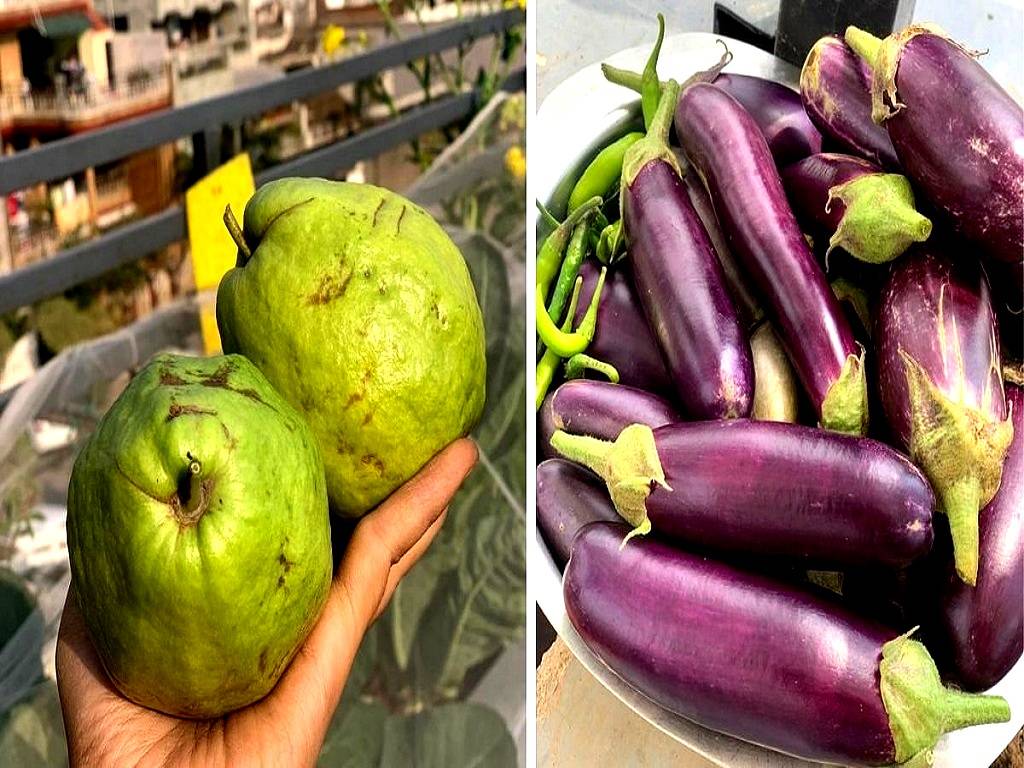
Ravneet Kaur's terrace garden at her Ludhiana house is a verdant sanctuary. She spends a lot of time among the greens, as she has over 200 plants.
"In 2019, I attempted cultivating wheatgrass for the first time for my father, who was unwell." "I never thought I had a green thumb," Ravneet added.
Consequently, during the lockdown, she began to experiment with cultivating new varieties of vegetables and fruits. Seeing them all thrive motivated her to plant more.
"I grew up in Chandigarh, where we had a large number of fruit trees in our garden." So, in a way, I grew up surrounded by nature. I missed that when I married and went to Ludhiana," she added. However, with time on hand during the lockdown, Ravneet started growing things on her terrace.
Her inspiration came from watching online videos of people growing plants on their terraces and in small spaces. “I draw a lot of inspiration from two avid gardeners – Garden Up by Ekta Chaudhry and Worm Rani’s videos. I started my journey with five pots,” she added.
A family that gardens together is a family that stays together
In Ravneet’s home, she said that her in-laws also enjoy tending to their garden. "My in-laws produce a wide variety of flowers." They're both intrigued about it. So I decided to cultivate veggies and fruits on the terrace. That added to the mix,” she said. She began by cultivating spinach and brinjal. I'm glad I started with this since they're relatively easy vegetables to cultivate," she explained.
"However," she added, "it hasn't been easy."
" I recall planting the brinjal and a lemon tree and waited for it to bloom. Despite the fact that they were easy to cultivate, I received nothing from them. What it taught me was patience – the more the patience, the better the chances of growing your food.”
After the initial hurdles, she began by growing zucchini and bitter gourd (karela). She stated she spends nearly two hours a day on her terrace tending to the plants. "I prefer going up in the afternoons when the sun is nice and bright in the winters. In the summer, I get up earlier in the day or even later in the evening."
While Ravneet says that she has never taken stock of how many pots she has, she is sure that they will be upwards of 200 pots. "I also have big flower beds that have been constructed all around the terrace," she continued, "so those cannot be counted as pots yet fit a lot of plants in them." The approximate space available to her is 2000 sqft.
A Plant Enthusiast
Ravneet described herself as a "plant aficionado" and has over 70,000 Instagram followers. "I pursued my Bachelors of Commerce (B.Com) followed by Masters in Business Administration (MBA), and then got a Bachelor of Education (B.Ed) degree."
" I had no connection with agriculture and yet I find so much joy in what I do. "The level of tranquilly I have when working with plants is quite gratifying," she added.
"I cultivate fruits and vegetables according on the weather. During the winter, I produced cauliflower, broccoli, cabbage, radish, and carrots. Now that summer is fast approaching, I am getting the pots ready for cucumber, bitter gourd (karela), lady’s finger (bhindi), pumpkin, squash, tomatoes and melons.”
Ravneet reported that the guava and lemon plants are doing well in their 20-inch plastic pots. On her Instagram page, Haryali_by_Cherie, Ravneet puts up videos on how to care for each crop.
She stated that you will fail at times as you embark on your quest of raising your own food. Either the weather isn't cooperating with you, or there's a pest infestation. "The best way to handle it is to keep going. Begin with the assumption that you might fail," she stated.
She stated that the yellow watermelons are her favorite of all the fruits and vegetables she grows. "Even the tomatoes I plant are one-of-a-kind and referred to as heirloom varieties that are resistant to the Indian climate. I acquired these seeds on Instagram from another gardener," she told.
4 Tips for Amateur Gardeners:
Be Patient
Everything will not expand at the same pace. Allow it the time it requires and you will reap the rewards. "I was trying to plant lemon and guava, but they both refused to fruit. I also spent time reading up about these plants with patience. That aided me in better nurturing them. Recently, both the plants gave me several fruits,” she stated.
Go Desi
"As much as possible, grow items that are indigenous to where you live," Ravneet advised. Look for desi seeds in your local nurseries and communities. You will notice that these plants growing much faster. Avoid buying seeds and saplings online or from people from different states. The soil conditions may not be suitable for growing what you've purchased.
Grow What You Eat
"It's pointless to raise fruits and vegetables that you don't consume. Make sure you grow and cultivate things that your family and you can enjoy," she said. Talking with local mali (gardeners) or nurseries can also assist you in procuring the plants and saplings that you want to nurture.
Always Grow Seasonal
"The greatest way to ensure that your plants flourish is to plant them according to the season." Planting the wrong things in the wrong season is a poor decision. There are specific winter and summer fruits and vegetables, so learn up before you start,” she added.
















